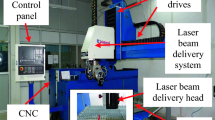Abstract
Laser forming is one of the most recent forming processes developed which uses a laser beam to induce a deliberate thermal stress on a workpiece to form a sheet metal. Accordingly, bending tubes using laser beam have attracted the attention of many engineers. In this paper, we studied the effects of various laser beam parameters on the tube bending process. To investigate the effects of all the parameters, we performed a large number of analyses and generated applicable tube laser bending data. We utilized Taguchi design of experiment method to manage the finite element simulation of the laser forming process. Subsequently, to have an easier, but more flexible and more complete laser forming data bank, we employed artificial neural networks to predict the required tube bending parameters for the proposed forming criteria. Finally, we used genetic algorithm programming to solve the multi-objective optimization with respect to the laser forming parameters. The objectives include maximum bending angle, minimum ovality, minimum thickening, and minimum forming energy consumption. The results from this study indicate that we can use applied data tables to find the optimum tube laser forming parameters. The outcome of the numerical experiments is consistent with the existing literature on the laser forming process.



















Similar content being viewed by others
References
Li W, Yao YL (2001) Laser bending of tubes: mechanism, analysis, and prediction. J Manuf Sci Eng 123(4):674–681
Hao N, Li L (2003) An analytical model for laser tube bending. Appl Surf Sci 208:432–436
Hao N, Li L (2003) Finite element analysis of laser tube bending process. Appl Surf Sci 208:437–441
Hsieh H-S, Lin J (2005) Study of the buckling mechanism in laser tube forming. Opt Laser Technol 37(5):402–409
Hsieh H-S, Lin J (2005) Study of the buckling mechanism in laser tube forming with axial preloads. Int J Mach Tools Manuf 45(12–13):1368–1374
Safdar S, Li L, Sheikh M, Liu Z (2005) The effect of beam geometry on stress distribution in laser bending of tubes. Int Congress Appl Lasers Electro-Optics 1:106
Zhang J, Cheng P, Zhang W, Graham M, Jones J, Jones M, Yao YL (2006) Effects of scanning schemes on laser tube bending. J Manuf Sci Eng 128(1):20–33
Safdar S, Li L, Sheikh M, Liu Z (2007) Finite element simulation of laser tube bending: effect of scanning schemes on bending angle, distortions and stress distribution. Opt Laser Technol 39(6):1101–1110
Guglielmotti A, Quadrini F, Squeo E, Tagliaferri V (2008) Diode laser forming of stainless steel tubes. Int J Mater Form 1(1):1343–1346
Wang XY, Wang J, Wang L, Xu W, Guo D (2011) Scanning path planning in laser bending of tube based on curvature. Adv Mater Res Trans Tech Publ 264–265:6–11
Gollo MH, Mahdavian S, Naeini HM (2011) Statistical analysis of parameter effects on bending angle in laser forming process by pulsed Nd: YAG laser. Opt Laser Technol 43(3):475–482
Cheng P, Lin S (2000) Using neural networks to predict bending angle of sheet metal formed by laser. Int J Mach Tools Manuf 40(8):1185–1197
Chen D-J, Xiang Y-B, Wu S-C, Li M-Q (2002) Application of fuzzy neural network to laser bending process of sheet metal. Mater Sci Technol 18(6):677–680
Du Y, Wang X, Silvanus Jr (2010) Improved BP network to predict bending angle in the laser bending process for sheet metal. In: 2010 International Conference on intelligent system design and engineering application. IEEE, pp 839–843
Shen H, Shi Y, Yao Z, Hu J (2006) Fuzzy logic model for bending angle in laser forming. Mater Sci Technol 22(8):981–986
Esfahani RT, Zojaji Z (2016) Optimization of finite element model of laser forming in circular path using genetic algorithms and ANFIS. Soft Comput 20(5):2031–2045
Maji K, Pratihar DK, Nath A (2013) Analysis and synthesis of laser forming process using neural networks and neuro-fuzzy inference system. Soft Comput 17(5):849–865
Imhan KI, Baharudin B, Zakaria A, Ismail MISB, Alsabti NMH, Ahmad AK (2017) Investigation of material specifications changes during laser tube bending and its influence on the modification and optimization of analytical modeling. Opt Laser Technol 95:151–156
Imhan KI, Baharudin B, Zakaria A, Ismail MISB, Alsabti NMH, Ahmad AK (2018) Improve the material absorption of light and enhance the laser tube bending process utilizing laser softening heat treatment. Opt Laser Technol 99:15–18
Guan Y, Yuan G, Sun S, Zhao G (2013) Process simulation and optimization of laser tube bending. Int J Adv Manuf Technol 65(1–4):333–342
Hibbitt H, Karlsson B, Sorensen P (2011) Abaqus analysis user’s manual version 6.10. Dassault Systèmes Simulia Corp, Providence
Hsieh H-S, Lin J (2004) Laser-induced vibration during pulsed laser forming. Opt Laser Technol 36(6):431–439
Scott P, Olson R, Bockbrader J, Wilson M, Gruen B, Morbitzer R, Yang Y, Williams C, Brust F, Fredette L (2005) The Battelle Integrity of Nuclear Piping (BINP) Program Final Report. No NUREG/CR-6837
Beale M, Hagan MT, Demuth HB (2011) Neural network toolbox, User’s guide, MATLAB. The MathWorks Inc, Natick
Author information
Authors and Affiliations
Corresponding author
Additional information
Publisher's Note
Springer Nature remains neutral with regard to jurisdictional claims in published maps and institutional affiliations.
Rights and permissions
About this article
Cite this article
Keshtiara, M., Golabi, S. & Tarkesh Esfahani, R. Multi-objective optimization of stainless steel 304 tube laser forming process using GA. Engineering with Computers 37, 155–171 (2021). https://doi.org/10.1007/s00366-019-00814-0
Received:
Accepted:
Published:
Issue Date:
DOI: https://doi.org/10.1007/s00366-019-00814-0




